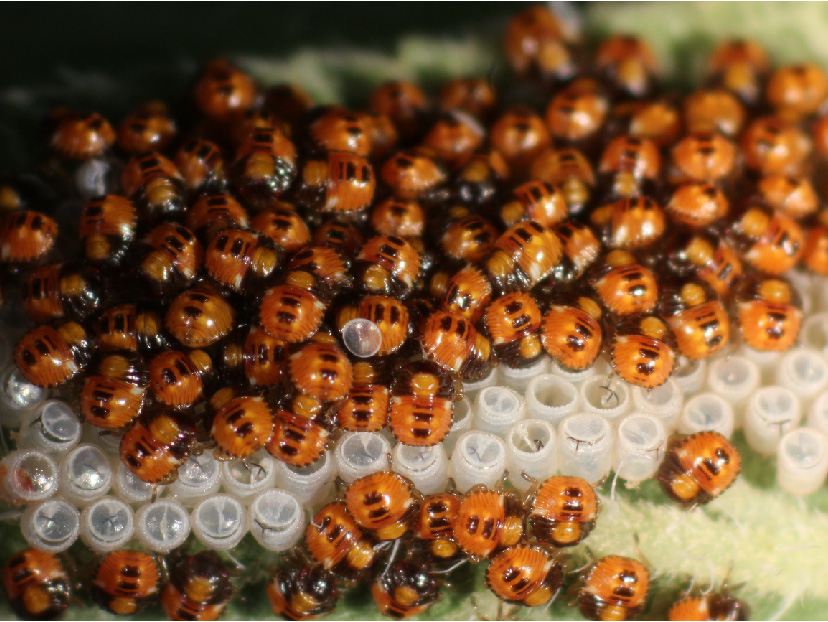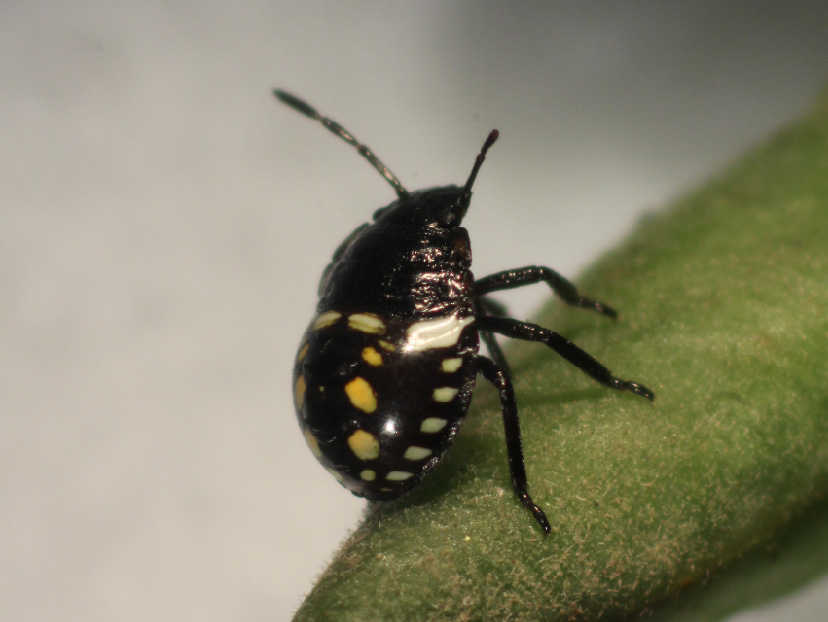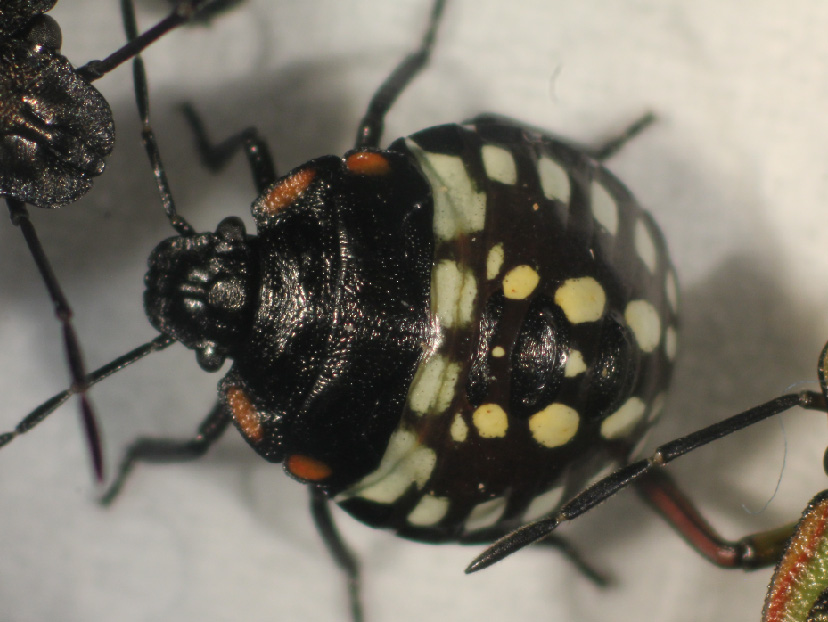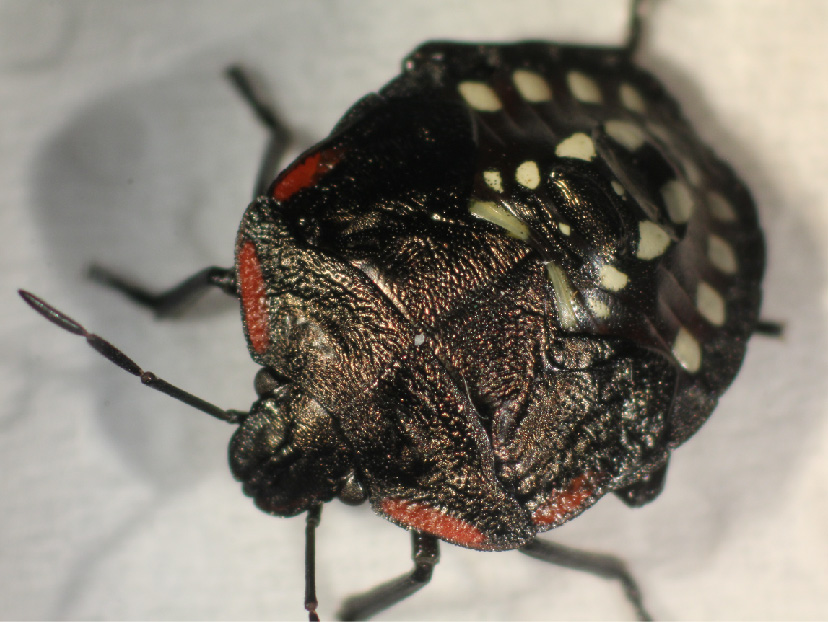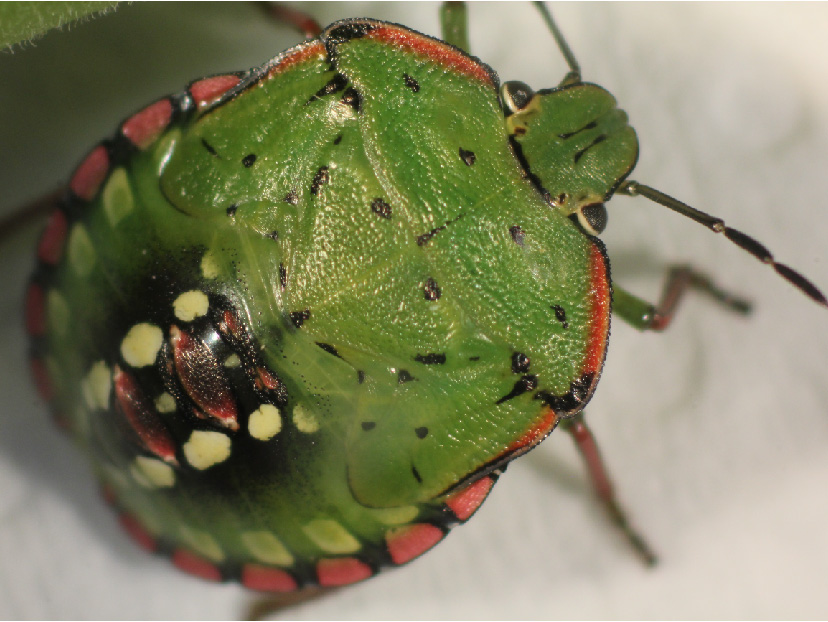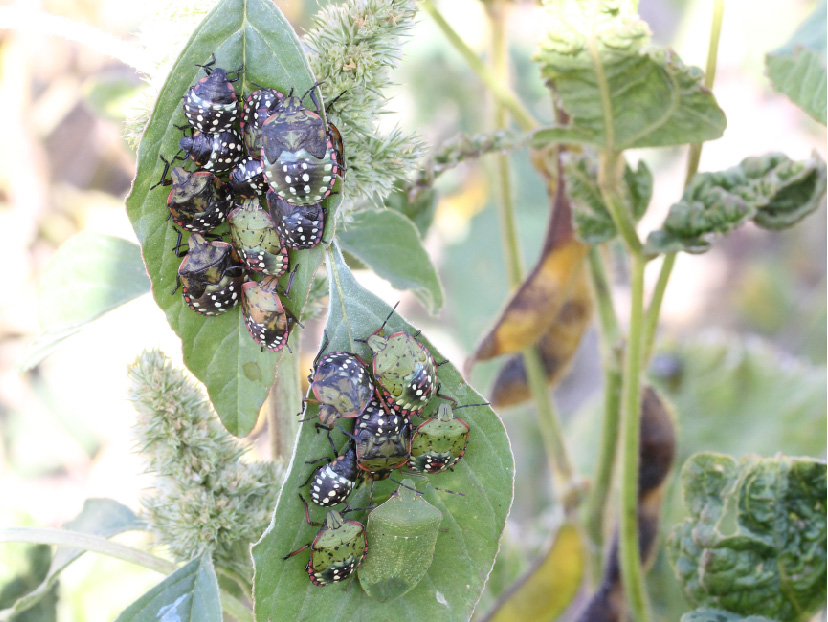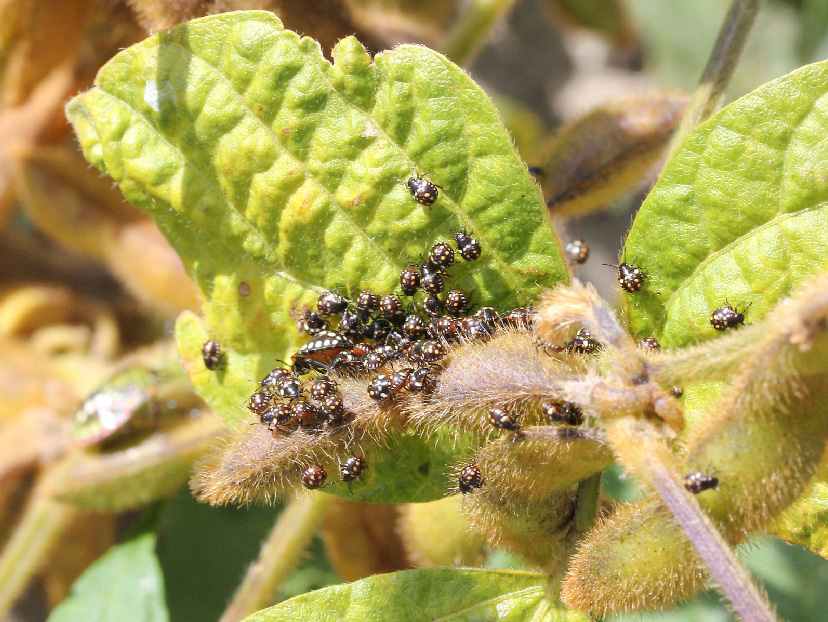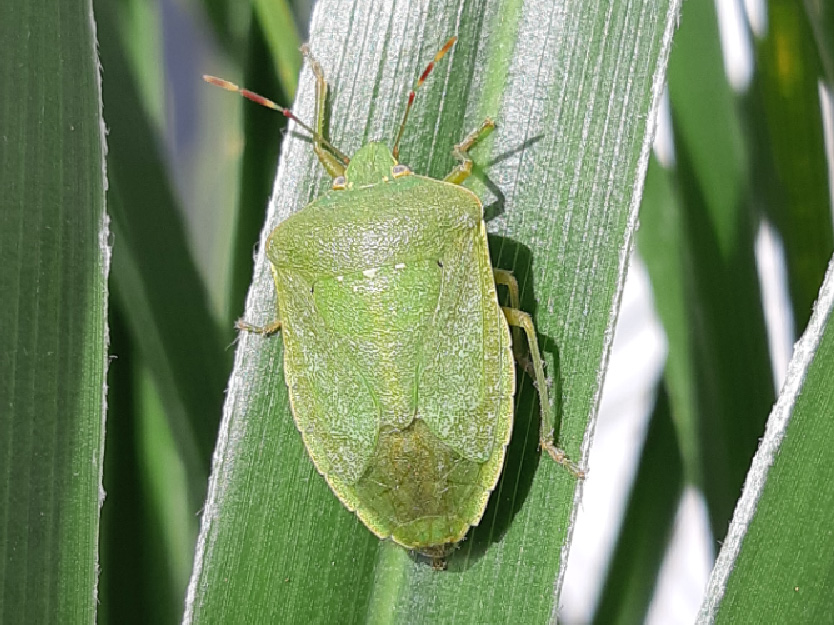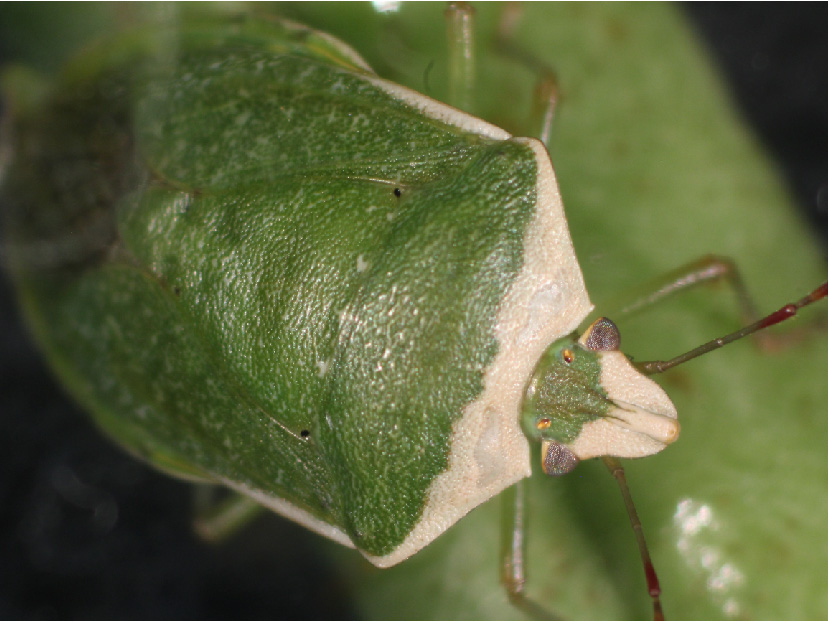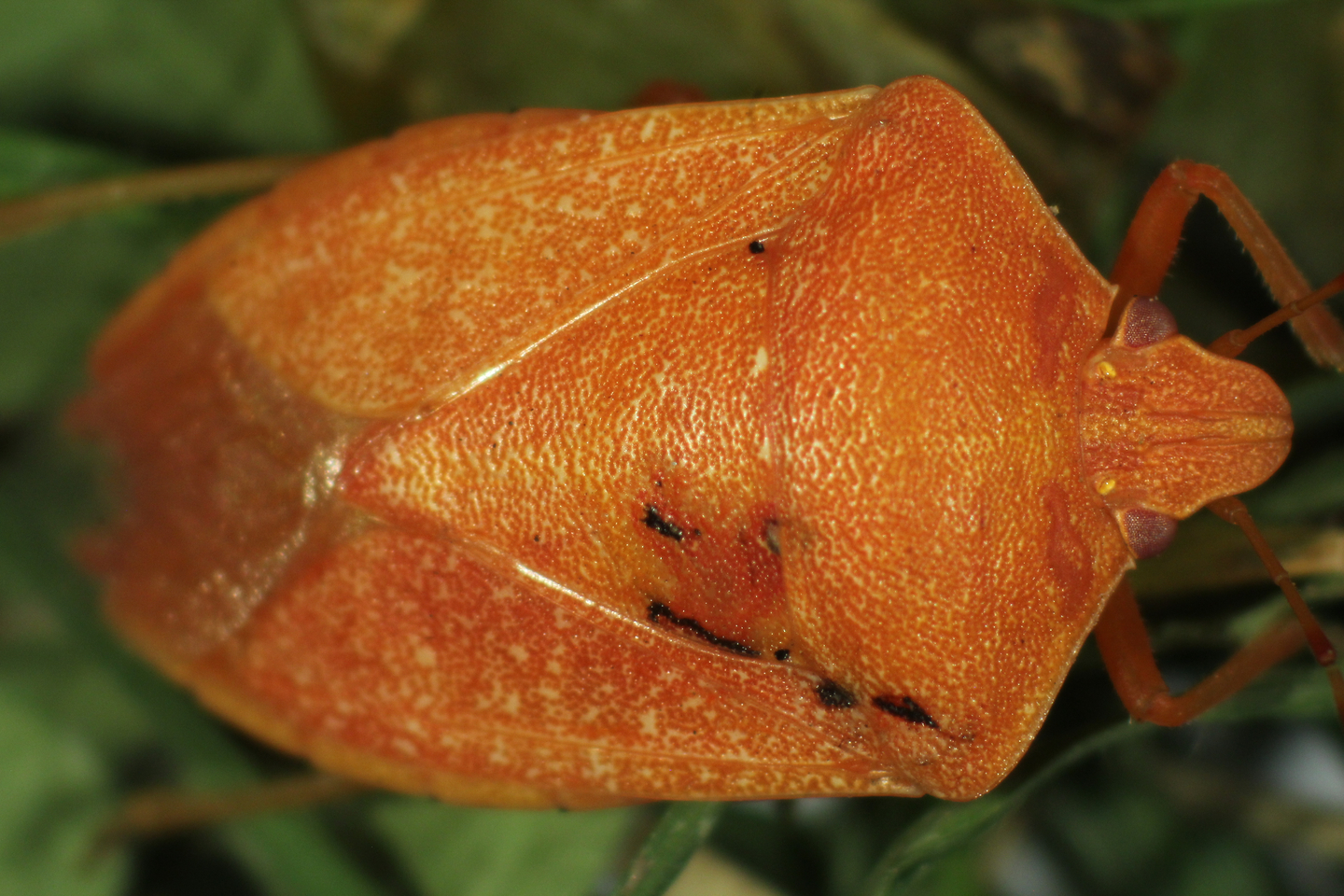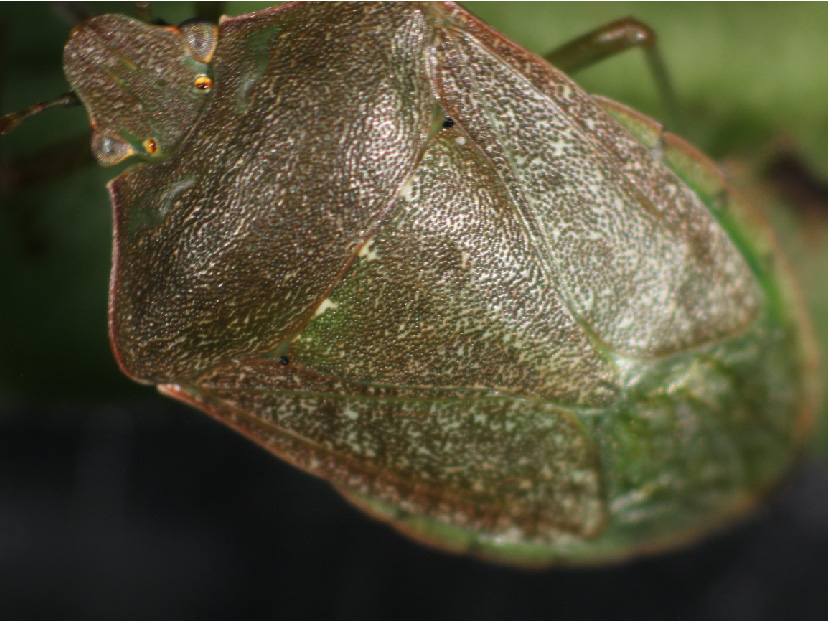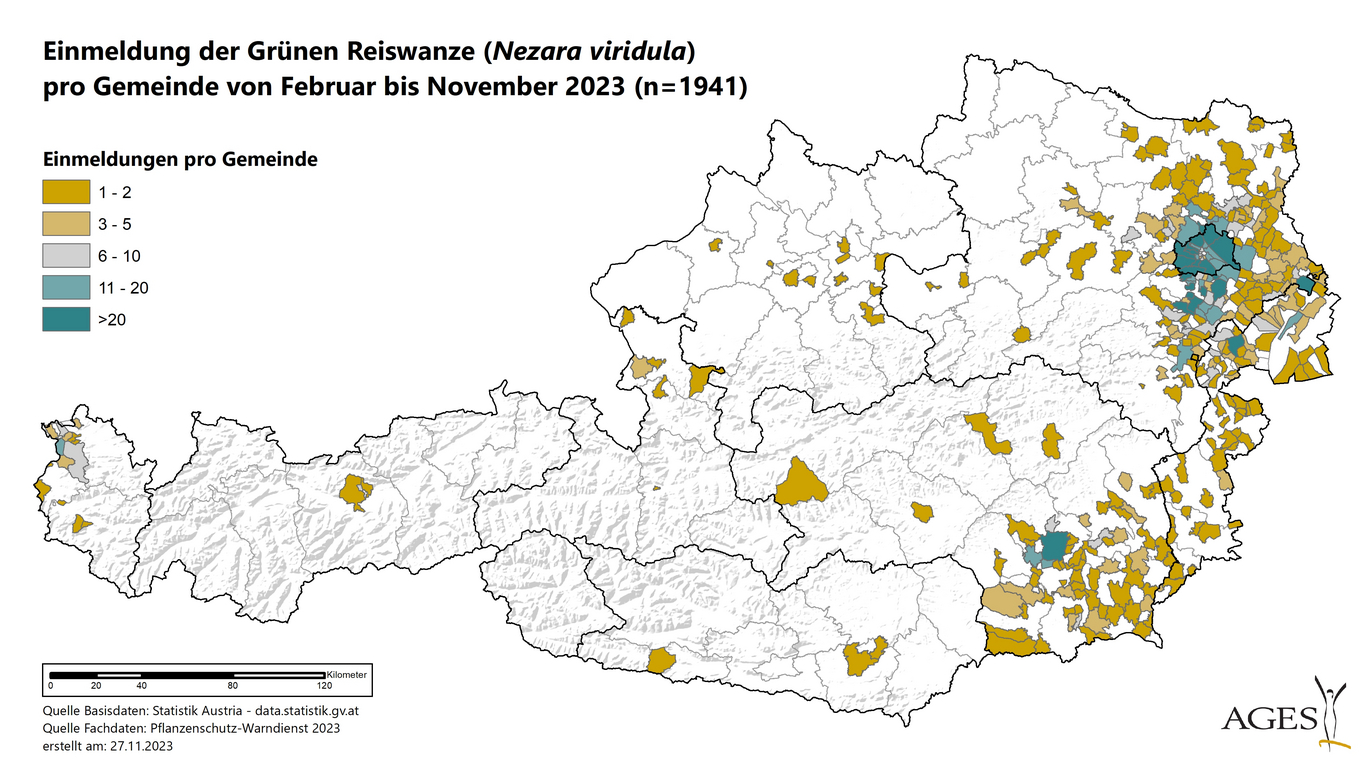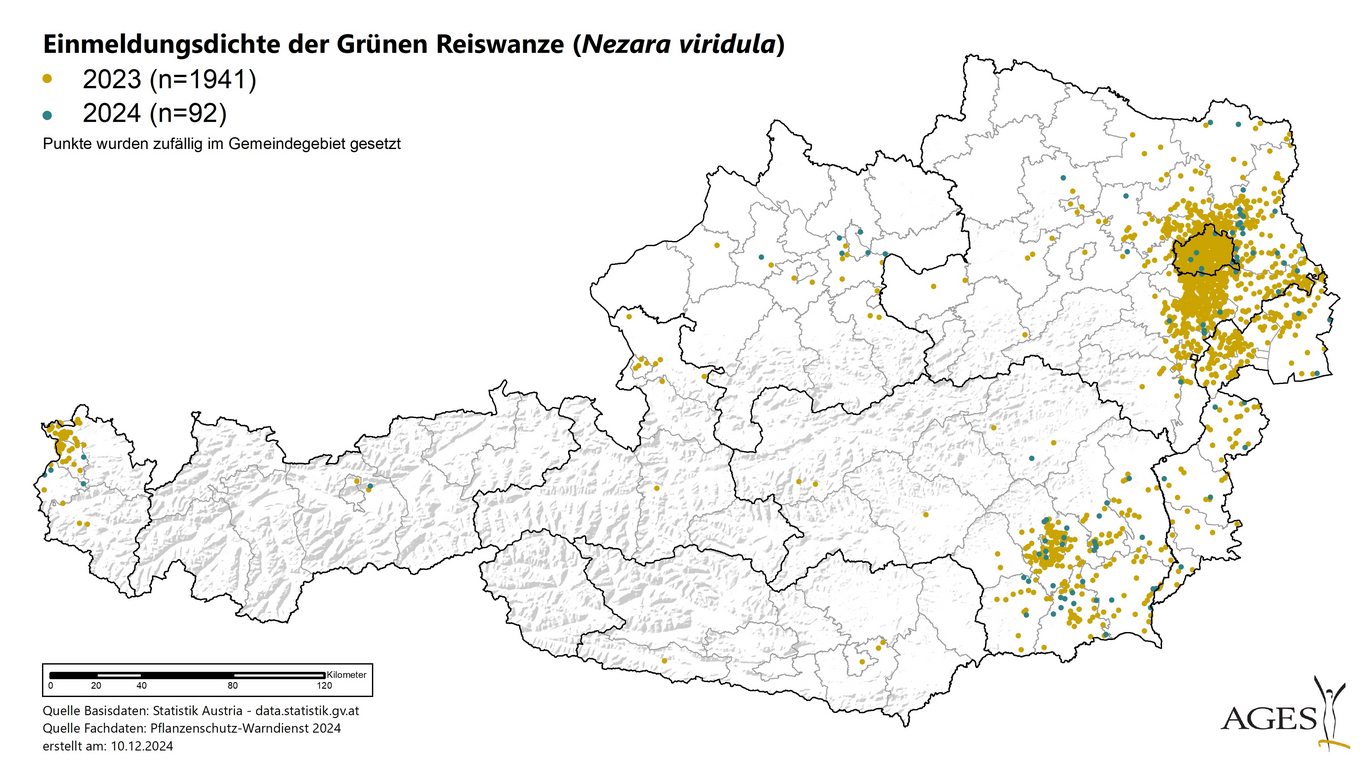Southern green stink bug
Nezara viridula
Appearance
The green rice bug belongs to the family of tree bugs and is approx. 14-16 mm long, 8 mm wide and usually green in colour, although there are also specimens with a white head and front edge of the pronotum and, very rarely, orange-coloured specimens. In autumn it changes colour from green to reddish-brown. The young bugs (nymphs) are very differently coloured and change their appearance with each stage of development. Newly hatched bugs are bright orange and then change colour to reddish brown. As they continue to develop, they become black in colour with white spots. Towards the end of their development into adult bugs, the green part usually predominates, with the lateral edges and the centre of the abdomen showing red and yellow dots.

Possibility of confusion
The Southern green stink bug looks very similar to the green stink bug(Palomena prasina), but the green rice bug can be easily distinguished from the green stink bug by the white row of dots on the front edge of the dorsal shield and the light-coloured transparent part of the elytra.
Biology
When the temperatures rise in spring, the adult bugs leave their overwintering quarters (e.g. ground litter, buildings) to start feeding. In April/May, the bugs mate and the females lay their first cream-coloured and later orange-coloured egg clutches, which contain up to one hundred individual eggs. The larvae that hatch from these eggs go through five very variably coloured stages, which are usually found in groups on the plants. In Austria, depending on the temperature in early summer, their development is completed after around two months and the first adult bugs of the first generation emerge, which start laying eggs again in June/July. From this, the second generation of rice bugs develops, which usually appears very conspicuously in late summer. A strong increase in the number of bugs can be observed in years with hot and dry summer conditions.
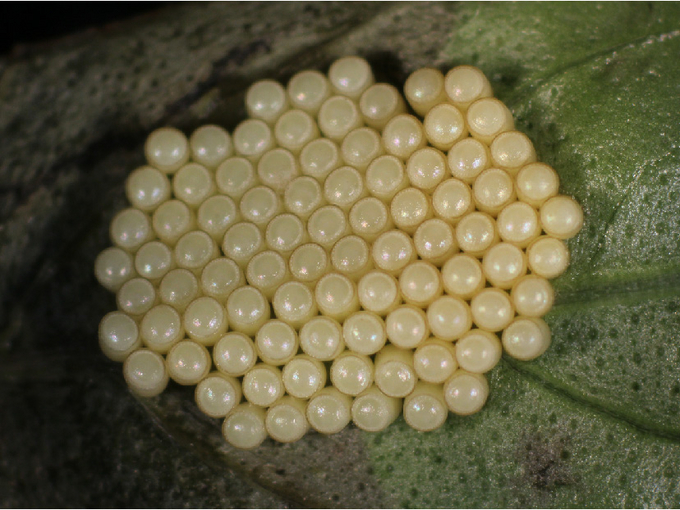
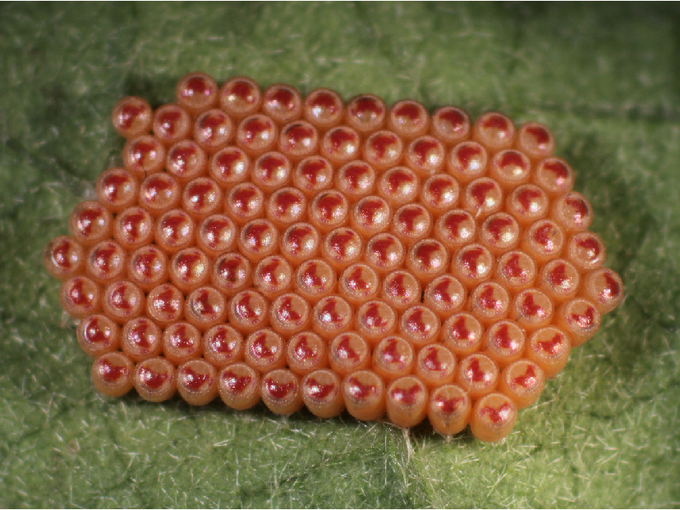
Damage symptoms
The Southern green stink bug can cause sucking damage to all above-ground plant parts. As a plant sucker, it is able to pierce plant tissue from young shoots, fruits, seeds, leaves and shoots with its proboscis in order to feed on the plant sap. Phytopathogenic viruses are not transmitted to the plants, but the sucking activity causes spotting, corking, deformation and death. Fruits become unsightly, can fall off prematurely and are no longer marketable.
In addition, flavour impairment is caused by the secretion of an unpleasant smelling secretion and the puncture sites can serve as entry points for pathogens.
An infestation by the green rice bug therefore has a qualitative and quantitative effect on the yield.
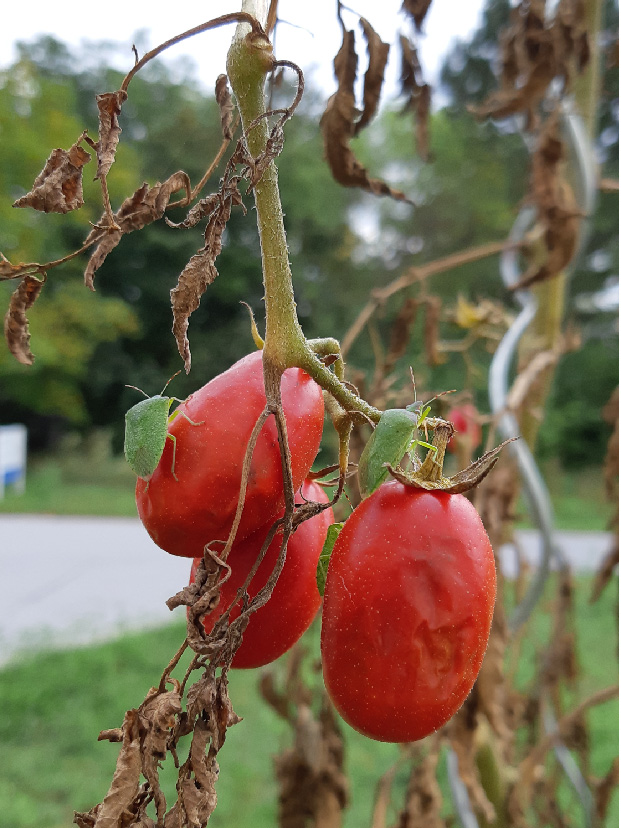
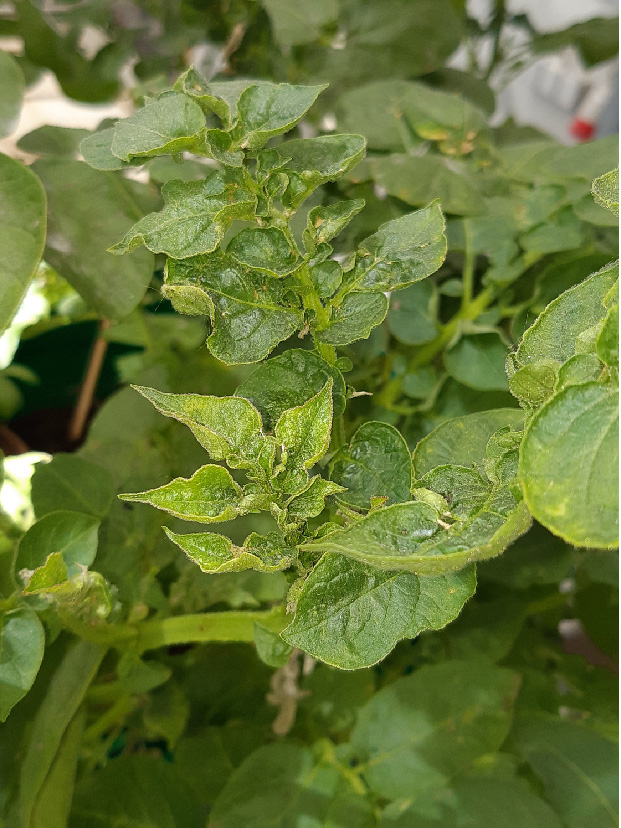
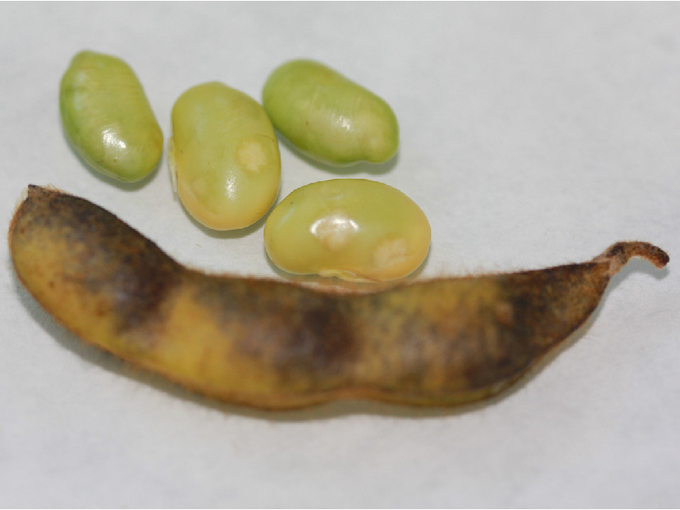
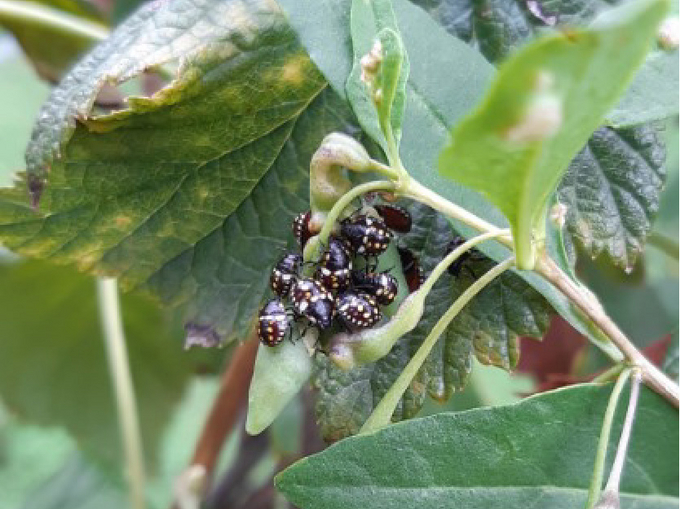
Host plants
The Southern green stink bug can feed on a wide variety of plant species from all crops. Its main host plants include legumes (e.g. soya, beans), but also vegetables (e.g. tomatoes, melanzani, peppers), fruit, wine and berries (e.g. apple, raspberry), as well as arable crops (maize, potato), herbs, ornamental shrubs and plants, various weeds and intercrops. Annual, herbaceous crops in particular are attacked especially at the time of fruit and seed formation.
Distribution
In Europe, the green rice bug was initially only found in the Mediterranean region. Due to global warming, however, it is increasingly spreading northwards. Until 2015, only individual animals were found in Austria. In the meantime, the green rice bug is considered established, as numerous larvae and adult bugs have since been detected in home gardens and glasshouses, especially in urban regions (Vienna and Graz).
In 2021, we were able to determine in a monitoring programme that the bug causes damage to gardens and agriculture, especially in late summer in Vienna and Graz, but also in Lower Austria and Burgenland. The green rice bug has also already caused damage to vegetables in protected cultivation. In greenhouse crops, the bug becomes active as early as January or February, as it can survive the winter in a dormant stage in structural parts of heated glasshouses. Due to the fact that the green rice bug has developed into a significant pest in recent years, a warning service has been carried out together with the Chamber of Agriculture since 2023 and 2024 to inform farmers about the current occurrence of the bug. Thanks to the numerous reports we have received in the course of rice bug monitoring, we have been able to create a distribution map for Austria.
Prevention and control
- Regular plant inspections to recognise infested individual plants as early as possible and to remove egg layers/larvae/adults by collecting them. A jam jar is best suited for this, which should then be kept in the freezer for a few hours to gently kill the bugs.
- To prevent the bugs from flying into the greenhouse, close-meshed (1-1.5 mm) insect screens can be fitted to the vents.
- Check greenhouses for bugs before planting susceptible crops.
- Direct control with authorised insecticides against sucking insects is possible, but difficult because it is usually not possible to achieve a sufficient effect against the adult bugs.
- Egg parasitoids (ichneumon wasp Trissolcus basalis) and endoparasites (caterpillar fly Trichopoda pictipennis) are described as natural antagonists. According to the plant protection product register, the ichneumon wasp Trissolcus basalis is authorised and commercially available in Austria for professional use outdoors and under glass in arable, vegetable, fruit and ornamental plant cultivation and for various crops in the home and allotment garden sector.
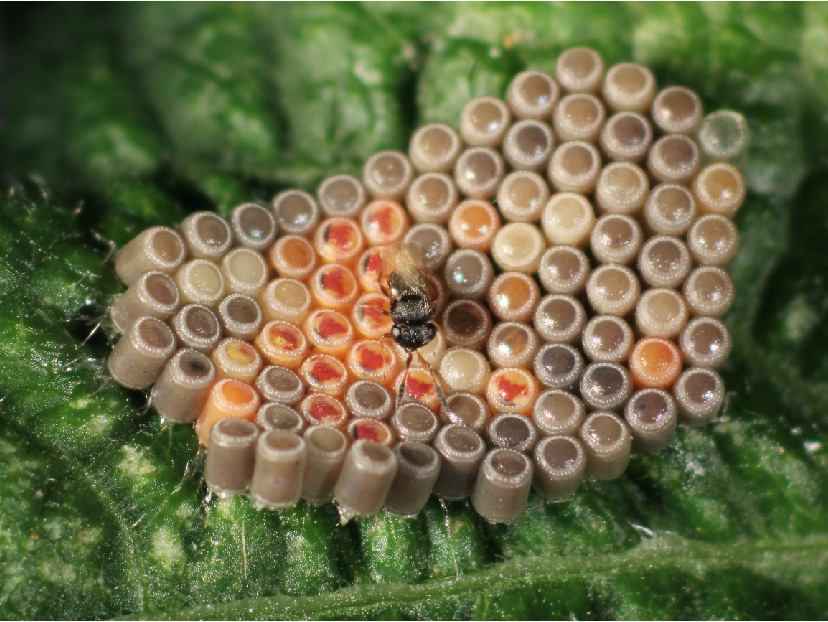
Online registration platform and warning service
In 2025, a registration platform will no longer be available, but the rice bug warning service will continue to be provided and offered on the corresponding website of the Chamber of Agriculture: Green rice bug warning service 2025 | Warning service - vegetables
Links
First detection of the egg parasite Trissolcus basalis in Austria
Information from the CABI invasive species compendium: Datasheet Nezara viridula
Information from LTZ Augustenberg
Last updated: 21.02.2025
automatically translated
